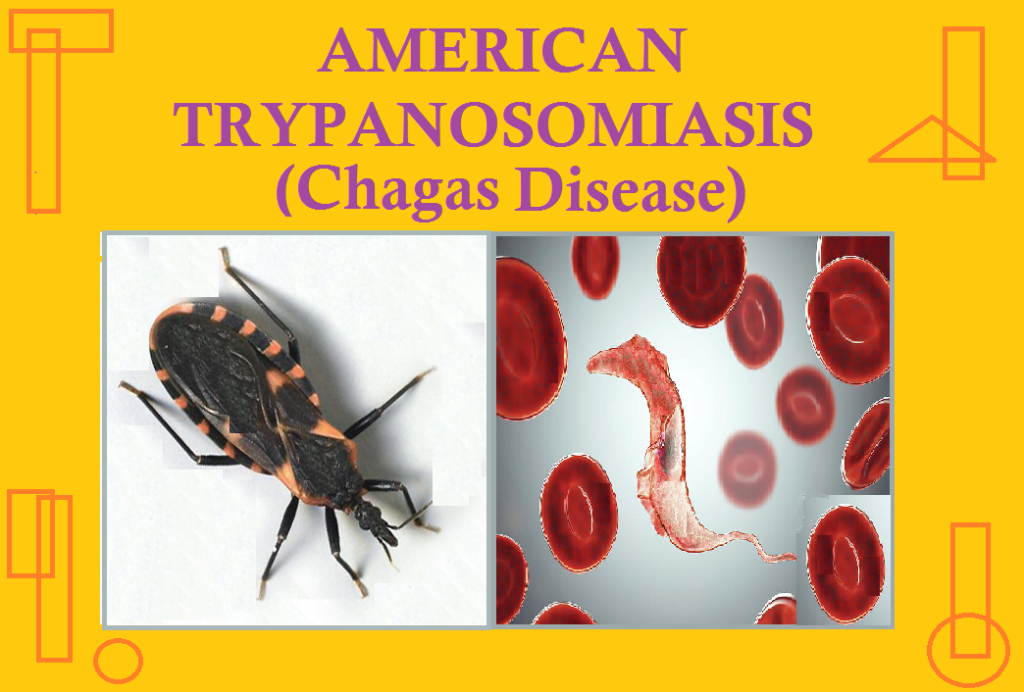AMERICAN TRYPANOSOMIASIS (Chagas Disease)
American Trypanosomiasis is caused by Trypanosoma cruzi, a protozoan parasite found only in the Americans; it infects wild animals and to a lesser extent humans from southern South America to the southern United States. An estimated 8-10 million people are infected, mostly in rural areas. The disease is often acquired in childhood. In many countries in South America, Chagas disease is the most important cause of heart disease.
Trypanosoma cruzi is transmitted by reduviid (triatomine) bugs infected by ingesting blood from animals or humans who have circulating trypanosomes. Multiplication occurs in the digestive tract of the bug and infective forms are eliminated in feces. Infections in humans occur when the parasite penetrates the skin through the bite wound, mucous membranes, and in conjunctiva. Transmission can also occur by blood transfusion, organ or bone marrow transplantation, congenital transfer, or ingestion of foods contaminated with vector feces. From the blood stream, Trypanosoma cruzi invades many cell types but has predilection for myocardium, smooth muscle, and CNS glial cells. Multiplication causes cellular inflammation, destruction and fibrosis, with progressive disease over decades.
SYMPTOMS
Mostly infected persons remain asymptomatic. The acute stage is seen principally in children and lasts for 1-2 months. The earliest findings are at the site of inoculation either in the eye or in the skin.
As asymptomatic latent period (indeterminate phase) may last for life, but symptomatic disease develops in 10-30% of infected individuals, commonly many years after infection.
Chronic Chagas disease generally manifests as abnormalities in cardiac and smooth muscle. cardiac disease includes arrhythmias, heart failure, and embolic disease. Smooth muscle abnormalities lead to mega-esophagus and megacolon, with dysphagia regurgitation, aspiration, constipation and abdominal pain. These findings can be complicated by superinfections. In immunosuppressed persons, including AIDS patients and transplant recipients, latent Chagas disease may reactivate; findings have included brain abscesses and meningoencephalitis.
In acute infection evaluation of fresh blood shows motile trypanosomes and fixedd preparation shows Giemsa stained parasites. Trypanosomes may be diagnosed in bone marrow, lymph nodes, or in pericardial/spinal fluid.
Molecular tests can be used to diagnosed parasites in organ transplant recipients. When these test are not useful then xenodiagnosis using laboratory vectors and culture or animal inoculation are used in diagnose testing. Chronic chagas disease is usually diagnosed serologically.

TREATMENT
Treatment is inadequate because the two drugs used, benznidazole and nifurtimox, often cause severe side effects, must be used foe long periods, and are ineffective against chronic infections. In acute and congenital infections, the drugs can reduce the duration and severity of the infection, but cure is achieved on only about 70% of patients. Nevertheless, there is general consensus that treatment should be considered in all T cruzi-infected persons regardless of clinical status or time since infection. In particular, treatment is recommended for acute, congenital, and reactivated infections and for children and young adults with chronic disease. Benznidazole is preferred due to better efficacy and safety profiles.
In South America, a major eradication program based on improved housing, use of residual pyrethroid insecticides and pyrethroid-impregnated bed curtains, and screening of blood donors has achieved striking reductions in new infections. In endemic areas, and ideally in donors from endemic areas, blood should not be used for transfusion unless at least two serologic tests are negative.
For Informational purpose only. Consult your Physician for advice.